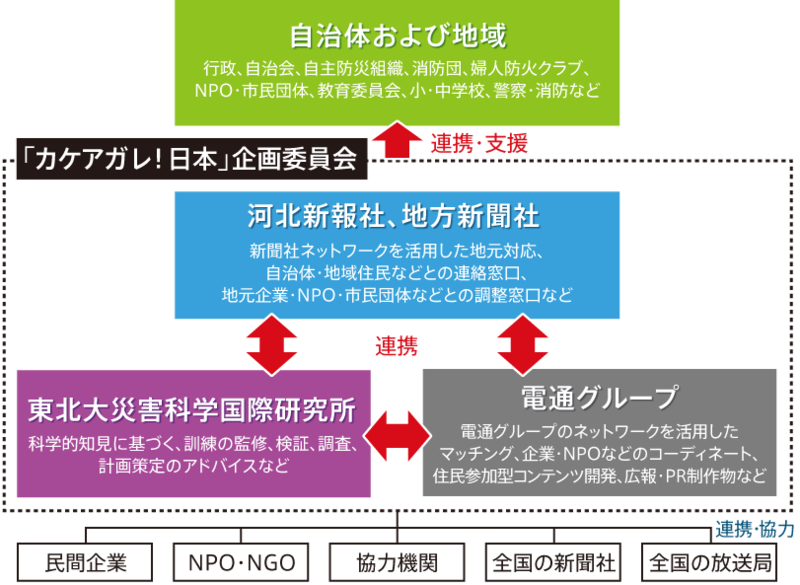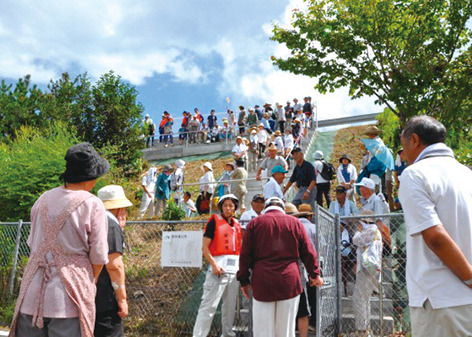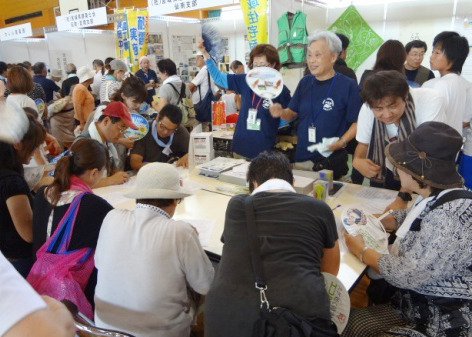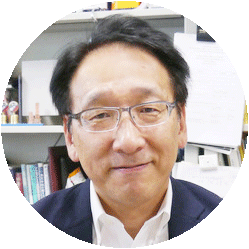Note: This website was automatically translated, so some terms or nuances may not be completely accurate.
Expectations Grow for Active Corporate Participation "Kakeagare! Nippon"

"Kakeagare! Nippon" is a new tsunami disaster prevention project originating in Tohoku. Under a public-private-academic partnership, it was first implemented in Iwanuma City, Miyagi Prefecture, in September 2012. Its goals are to pass on the experiences and lessons of the Great East Japan Earthquake and to make evacuation actions habitual. The project is expanding its implementation areas. Selected as a "New Tohoku" Leading Model Project by the Reconstruction Agency, training has also been conducted in Thailand. How does it differ from conventional drills? We introduce its specific activities, achievements, challenges, and future developments, incorporating interviews.
Aiming to Develop Training Programs Tailored to Regional Characteristics
The project's concept is a "Grand Menu for Tsunami Evacuation," meaning the development of training programs tailored to local circumstances. By repeatedly conducting training using these programs, the project aims to solve evacuation challenges specific to each region, promote the habit of evacuation actions, and expand the initiative nationwide and overseas.
Training implementation centers on the "Kakearage! Nippon" Planning Committee, composed of three entities: Kahoku Shimpo (regional coordination), Tohoku University International Research Institute of Disaster Science (scientific basis), and Dentsu Group (planning, corporate matching). This committee facilitates collaboration among local governments, communities, businesses, NPOs/NGOs, and national media (see diagram below). Activities are carried out by leveraging the expertise and know-how of industry, government, and academia, with each playing its role.

Higher ground, via expressways. Faster response, by vehicle.
The project's basic framework is "Tsunami Evacuation Drill + Workshop." After the drill, resident-participation workshops and surveys are conducted. Disaster awareness is heightened through activities like booths run by citizen groups.
For the first drill in Iwanuma City, the only available "high ground" was the emergency stairway along the shoulder of the Sendai Eastern Expressway (highway). With no surrounding mountains or tall buildings, this was designated as the evacuation site. Approximately 1,450 residents participated, about 30% of the target population. The local rule of "rush up to the highway" drew significant attention, with extensive coverage by national media.
Similarly, a drill in Yamamoto Town, Miyagi Prefecture (August 2013), which also lacks surrounding high ground, focused on "vehicle evacuation." Approximately 3,000 people and 600 vehicles participated, testing the challenges of this approach. In June of this year, the drill was conducted in the Otsurige district of Kushiro City, Hokkaido, in collaboration with the Kahoku Shimpo newspaper's traveling workshop, "Musubi Juku." It is scheduled to be rolled out in both Iwate and Fukushima Prefectures within this fiscal year.



Ten years since the Sumatra earthquake. Phuket also says "Kakaagare!"
"Kakaegare!" in Phuket too. About 70 children ran up the hill behind their school building
Phuket, Thailand, suffered devastating damage from the Indian Ocean tsunami triggered by the 2004 Sumatra earthquake. Marking the 10-year anniversary, on June 18, Tohoku University's Disaster Research Institute led disaster prevention lessons and tsunami evacuation drills at local Bang Kha Lim Elementary School. Approximately 70 students from grades 4 to 6 participated.
At the time, the entire school building was submerged up to the second floor. In the current three-story new building, the third floor serves as the evacuation site. During the Tohoku University Disaster Research Center's lesson, after explaining the mechanism and terrifying nature of tsunamis, group work was conducted on the theme "Where would you escape if a tsunami came now?" The children confirmed safe locations by cross-referencing with tsunami inundation maps. For the drill, assuming a tsunami exceeding the height of the current school building, the children ran up to the higher hills behind the school.
Sharing Tohoku-born Initiatives at the UN World Conference on Disaster Risk Reduction
Kakeagare! Japan steadily builds its track record both domestically and internationally. Beyond drills, it focuses on sharing and disseminating information through workshops and symposiums on themes like evacuating with pets and guiding the elderly and disabled, as well as launching a portal site (kakeagare.jp). Recognized for these efforts, it was selected for the Reconstruction Agency's "New Tohoku" Leading Model Projects in fiscal years 2013 and 2014.
As expectations for the project grow, where lies the key to further enriching and invigorating its activities? Hiroto Kimura (Kahoku Shimpo) of the Planning Committee states, "The key lies in corporate participation. There is significant potential to integrate corporate products and services into evacuation programs. Next March, the Third United Nations World Conference on Disaster Risk Reduction will be held in Sendai. We aim to communicate initiatives originating from disaster-affected Tohoku—efforts to protect lives and communities—both domestically and internationally, striving to ensure they are passed down across generations and become firmly established locally."

Disaster prevention initiatives directly impact corporate business activities

Fumihiko Imamura
Director and Professor, International Research Institute of Disaster Science, Tohoku University
Specializes in tsunami engineering and natural disaster science. He has consistently sounded the alarm about weaknesses in countermeasures against giant tsunamis since before the Great East Japan Earthquake. Former President of the Japan Society for Natural Disaster Science; served as a member of the Cabinet Office Central Disaster Prevention Council Expert Panel, among other positions.
We spoke with Professor Fumihiko Imamura of Tohoku University, Director of the International Research Institute of Disaster Science (IRIDOS) – a core research institution for the "Kakaegare! Japan" project – and a leading expert in tsunami engineering, about the project's challenges and future direction.
The concept for evacuation drills in the project involves creating detailed, tailored plans based on the vastly different geographical conditions, population sizes, and transportation environments across regions, and establishing a habit of conducting these drills. To make this meaningful, there are many challenges that need to be addressed.
If I were to highlight two, one is the generational gap among residents. The elderly have high disaster awareness and are eager to participate in drills. Children participate in drills and events, though there are differences between schools. On the other hand, the working-age generation finds participation relatively difficult. We want to explore and incorporate ways to make drills something all generations can habitually participate in.
The other is responding to earthquakes and tsunamis exceeding the scale of past experiences and research. Indeed, during the Great East Japan Earthquake, tsunami waves reached designated evacuation sites, claiming the lives of approximately 90 people. Even if historical lessons remain within the community and a certain level of training has been conducted, when events exceed expectations, individual situational judgment ultimately determines life or death. Educational and awareness activities to cultivate this ability must also become part of the training. We aim to explore countermeasures to address these challenges and develop diverse training programs.
Moving forward, to elevate the "Kakeagare! Japan" initiative to the next level, we believe greater participation from companies in their core business activities is essential. We strongly urge companies to recognize that disaster prevention efforts can directly connect to their business operations. For example, for automobile and car navigation system manufacturers, this project holds significant meaning as a testing ground for implementing disaster prevention features. During the Great East Japan Earthquake, many people lost their lives after being swept away by the tsunami while still in their vehicles. There are numerous themes for disaster prevention technologies to protect drivers' lives, such as developing systems for immediate evacuation guidance via car navigation or researching vehicle structures that ensure safety inside even if swept away by a tsunami. We also hope for participation from companies in IT, transportation, infrastructure, and other fields that have traditionally had little connection to tsunamis or disaster prevention.
Recovery from the Great East Japan Earthquake is still only halfway complete. While some argue that community building should come before evacuation drills, there are things that can only be done now. Before awareness of evacuation declines, we want to share experiences and memories and advance this project through integrated efforts among industry, government, and academia.
Related Article:
Shimbun! What We Can Do Now. What Can Only Be Done Now. #14
What Newspapers Can Do for Tohoku Recovery (4) 2014.08.08
Was this article helpful?